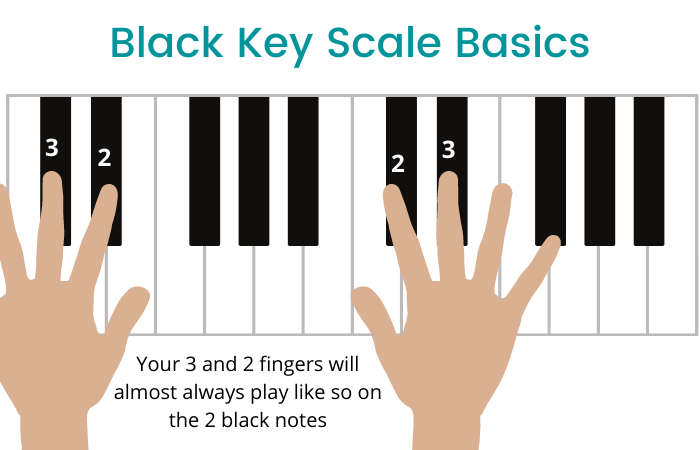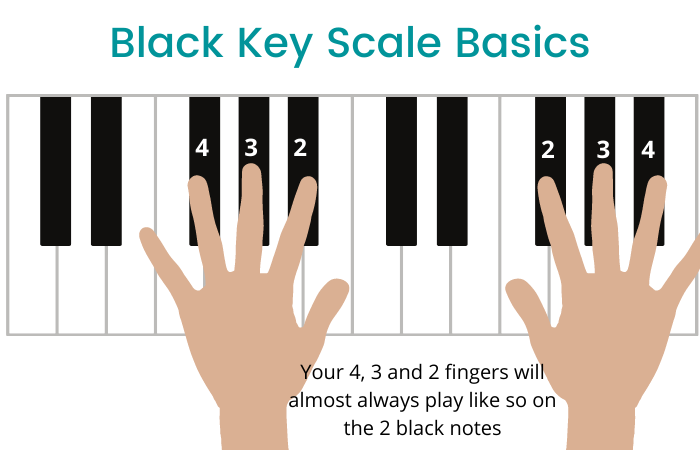A bright beautiful scale: the F# piano scale! The F# major scale is perfect to learn right after learning Db major. I like to think of these two scales as the “first group” of black key scales to learn together. They have similar fingerings and both use all 5 black notes. So are you ready to jump in?
What is the F# scale in piano?
The F# scale, simply put, is a major scale that both starts and ends on the note “F sharp.” It follows the typical pattern of half steps and whole steps that builds a major scale. As a result of that, we get a scale that has 5 black notes, but 6 sharps (one white key has to be sharped for the spelling of the scale to work).
What are the notes in the F# major scale?
The notes in an F# scale are as follows: F#, G#, A#, B, C#, D#, and finally E#. That last note, E# is the white note sharp I was talking about. I’ll show you diagrams and sheet music with these notes soon.
BEFORE You Begin
Stop! Before you learn the F# scale, it is important to learn easier scales first. F# major is an intermediate scale, while white key scales are perfect for beginner.
If you’re a beginner, start by learning these scales:
And after you learn those, THEN you can start doing black key scales. I recommend learning Db major as your very first black key scale, and then coming to this post to learn F#.
Black Key Scale Basics
There are some important black key scale basics to talk about when you’re just getting started. We already covered this when talking about the Db scale, but let’s still review it again before jumping into F#.
Remember, black key scales have very different fingerings from white key scales, so it is helpful to have some patterns to refer to.
It is the groupings of the black notes that also determine the fingering. Humor me for a second, and form the number two with your fingers (so hold up your 2nd and 3rd fingers). Now, place these on the two black notes. Those are the fingers we almost ALWAYS play on those black notes in the scales.

Now, form the number 3 with your fingers, in a W form (2nd, 3rd, and 4th fingers). Place these fingers on the 3 black notes. Those are the fingers we almost ALWAYS play on this group of black notes in scales!

This “rule” is completely true for both Db and F# scales. In fact, I like to think of these two scales as being in a group together because they are so similar.
Some of the next scales we’ll learn do have exceptions to the rule. But for now, you don’t have to worry about that.
F Sharp Scale Piano Notes & Fingerings
Now that you’ve completed those prerequisites, let’s get right into the details about the F# scale! Below you can start looking at the notes in the scale on a piano diagram. You will also find the fingerings for both right and left hand underneath.

How to Play the F# Scale on the Piano
To play the F# scale on the piano, press down each note shown in the diagram above, starting with the F# on the far left and working your way to the F# on the far right. Each note should be played as its own distinct note, yet still connected (don’t blur them together, but also don’t play them too short).
As far as fingering goes, F# has the same fingering as Db, except that it starts on a different note. This is largely due to the fact that they both use all 5 black notes.
To play the F# scale in the right hand, start with your 2 on F#, then play your 3 on F# and 4 of A# (there you can see the rule we talked about earlier in action!) Cross your 1 onto B, then play 2 on C# and 3 on D#. Cross your 1 again onto E# (aka F) and then finish with 2 on F#.
To play the F# scale in the left hand, start with your 4 on F#, and then do 3 on G# and 4 on A# (once again, it follows the rule!) Play your 1 on B, then cross your 3 onto C# and play 2 on D#. Finish by crossing your 1 to E# (aka F) and playing 2 on F# at the top.
Whew, and there you have it, you made it up the F# scale! Can you feel how similar this is to Db? The only difference is we’re starting on the 3 black notes rather than the 2 black notes.
F# Major Scale On The Staff
Below you can see the F# major scale written out on treble clef and bass clef. It is a good idea to not only look at a scale on the piano, but also see what it looks like on the music! This scale in particular is unique because of the E#. On the piano, your brain may read the E# as an F, but on the music you have to stay true to the correct spelling. 😉

Some Scale Tips
Hopefully F# is slightly easier for you since you already know a black key scale! But if you’re still having trouble, here are my best black key scale tips.
Pay attention to the white notes! In the F# scale, there are only 2 white notes, so it can actually be more helpful to focus on them rather than the black notes. Here’s a little fingering trick: your thumbs will ALWAYS play on the white notes (B and F) for this scale! So as long as you start on the right fingers, you can repeat that to yourself while playing—”thumbs on B and F.”
The key to black key scales is finding the pattern. You can always find some kind of “group” of notes in a particular scale to help you remember. For F#, we have the two groups of black notes, with the white notes in between.
F# is the only black key scale with a unique left hand fingering. All the other black key scales have a consistent left hand starting on the 3rd finger. So pay special attention to F# since it’s a little different!
Scale Intervals
All major scales follow a formula as far as intervals go. Here is this formula: W-W-H-W-W-W-H. The W’s stand for “whole step” and the H’s stand for “half step.
So written out the long way, the formula is: whole step, whole step, half step, whole step, whole step, half step.
You can use this formula any time to figure out a major scale!
When you use this formula, it also creates a relationship between the tonic (the very first note) and all the other notes. An interval can be formed between the tonic and each note of the scale. Here’s what that looks like for F# major:
- Tonic: F#
- Major 2nd: G#
- Major 3rd: A#
- Perfect 4th: B
- Perfect 5th: C#
- Major 6th: D#
- Major 7th: E#
- Perfect 8th: F#
Scale Degrees:
Another way to look at a scale is by “degrees.” Here are the scale degrees for the key of F#:
- Tonic: F#
- Supertonic: G#
- Mediant: A#
- Subdominant: B
- Dominant: C#
- Submediant: D#
- Leading tone: E#
- Octave: F#
Triad Chords In The Key Of F#
Did you know a chord can also be built off of EVERY note in the F# scale? That’s right! It is a great exercise to practice finding these chords in each key. There are quite a few sharp chords that you’ll see here, so pay careful attention.
Chord I: F# major (notes are F# – A# – C#)
Chord ii: G# minor (notes are G# – B – D#)
Chord iii: A# minor (notes are A# – C# – E#)
Chord IV: B Major (notes are B – D# – F#)
Chord V: C# major (notes are C# – E# – G#)
Chord vi: D# minor (notes are D# – F# – A#)
Chord vii: E# diminished (notes are E# – G# – B)
Is F# Major The Same As D# Minor?
D# minor is not the exact same key as F# major, but it is called the “relative minor.” All major keys have relative minors! This basically just means they have the same number of sharps in the key signature.
Why does the F# scale have E#?
The F# scale has to include E# because of the natural spelling sequence. A scale can never have 2 of the same letter note. If it was spelled as F instead of E#, then you’d have an F and an F# in the same scale, which doesn’t work. The alternative is to call the note E#. As much as this can be annoying, it is necessary.
Scales To Learn Next:
Woohoo, you have now learned your first “group” of black key scales! Next, you’ll want to move onto group 2, which includes the Eb scale, Ab scale, and Bb scale. I do recommend learning the scales in this order.
After this, you can also learn about other enharmonic scales (enharmonic means the same notes, but different spellings). This includes scales like C# major, Gb major, and D# major. Learning these scales is great for music theory knowledge, but you won’t have to play anything different than you already know since they are the equivalent notes to Db, F#, and Eb.
More Music Theory:
Definitely don’t stop at scales when it comes to music theory! Here are some black key chords that you should definitely be learning along with your scales:
Conclusion
The F# major scale is a bright, fun scale that uses all 5 black notes on the piano. Definitely take your time and master this scale! Start by playing your hands separately, and then put them together. Take your time, and slowy but surely you’ll be playing like a pro. You got this!
